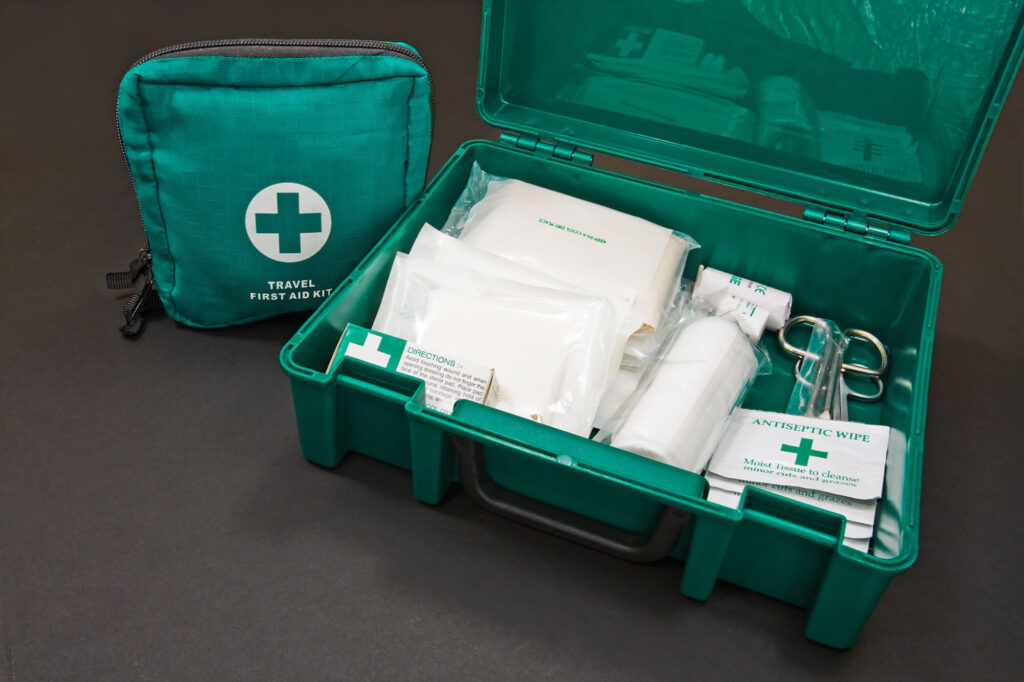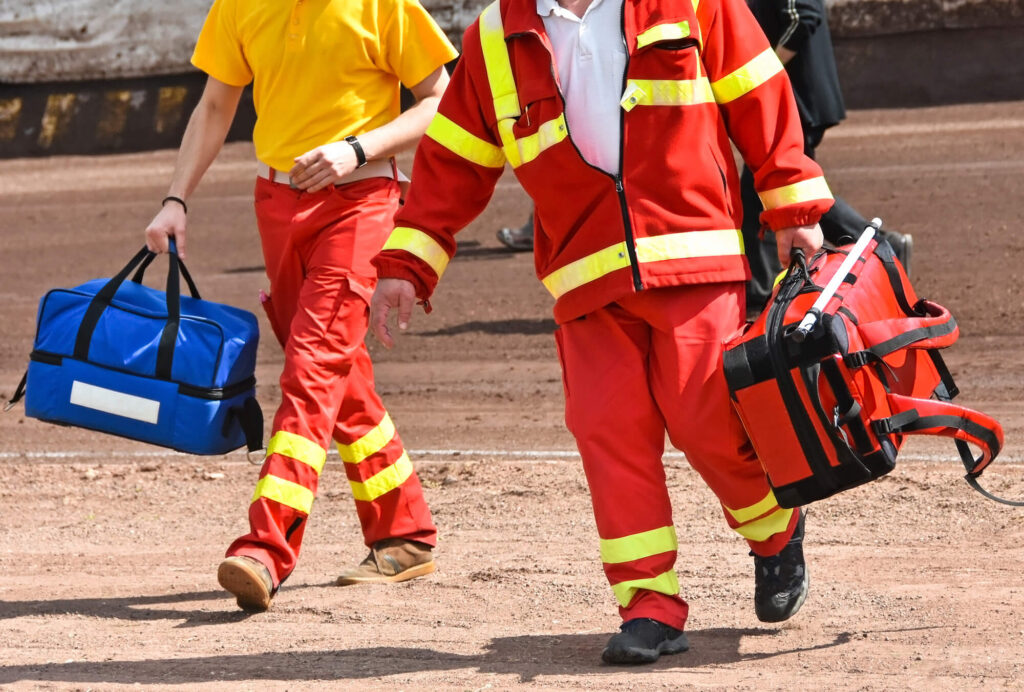Have you ever wondered how a simple box can be a lifesaver? Picture this: an ordinary office day turns chaotic with an unexpected injury. It’s in these critical moments that a first aid kit becomes more than just a box; it’s a beacon of hope.
With over 1.7 million work-related illnesses reported and 142 workers fatally injured at work in 2020/2021, the significance of these kits is undeniable. In this article, we dive into the world of first aid kits, uncovering the essential items they should contain, their legal requirements, and their profound impact in various environments. From offices to construction sites, we’ll explore how these kits stand as silent guardians, ready to offer aid when it’s most needed.
Having a first aid kit on hand can save a person’s life in an emergency. If not, the injured individual’s condition may deteriorate before they can reach a hospital and receive medical assistance. Additionally, it is a legal requirement to have a workplace first aid kit under the 2015 Health and Safety at Work Act. This article discusses the first aid kit requirements, contents, and fields of application.
Key Takeaways
- A first aid kit is a bag, box, or pack that contains materials and tools used to treat minor injuries and give emergency treatment.
- The requirements are the essential items that a first aid kit should have.
- Employers are obligated by law to provide first aid supplies to ensure workplace safety.
What Is a First Aid Kit?
A first aid kit is a bag, box, or pack containing life-saving supplies that can be used to assist a sick or injured person until full medical assistance or emergency services are available. It also includes personal protective aid equipment, medicines, medical equipment, survival supplies, and convenience items. The kit is created based on the types of emergencies in the workplace. The first aid kit should be kept in a cold, dry place. This position should also be out of the reach of children.
Unfortunately, workplace injuries and illnesses are not uncommon. According to the HSE’s Health and Safety Statistics 2020/2021:
- 142 workers were killed at work.
- 0.4 million workers suffered a non-fatal injury.
- 1.7 million cases of work-related illness (new or long-standing) were reported.
- 12000 workers died of lung disease.
ToolSense is trusted by 700+ companies



What Are First Aid Kit Requirements?
First aid arrangements are legally required in all businesses. First aid supplies, on the other hand, are not mandated by law, but they are a must-have pack.
BS 8599-1 First Aid Kit Standard
All first aid kits in the workplace must meet British Standard (BS) 8599-1, which outlines what is in the first aid kit. By BS 8599-1, a first aid kit’s size and scope are calculated based on the number of employees and the level of risk.
Why is the Standard Changing?
British standards are reviewed every 5 years and can be adjusted according to current conditions. The latest standard BS 8599-1:2019 has been published in January 2019.

Checklist for Basic First Aid Kit Items
Every business, regardless of size, should have a first-aid kit. The first aid kit contents will be determined by the results of a first aid needs assessment. This procedure involves numerous variables, such as identifying potential dangers, the task at hand, and the number of people involved.
Certain factors must be considered while determining the requirements for a first aid kit. For instance, COVID-19 testing should be considered to protect first responders and everyone involved.
Workplace safety inspections save costs, help you stay compliant with local regulation and reduce downtime.
Workplace First Aid Kit Contents: What Should Be in a First Aid Kit?
The following are the minimum acceptable number and types of supplies for first aid kits. The minimum requirements for workplace first aid kits are:
- Tweezers
- 2 triangular bandages
- Adhesive tapes
- Box adhesive bandages
- One emergency blanket
- Adhesive bandages
- Two elastic wraps
- Directions for requesting emergency assistance
- Two large sterile gauze pads 8 × 10 inches (ca. 25 cm)
- A roller bandage 4 inches (ca. 10 cm) wide
- 2 pairs of nonlatex gloves
- Scissors
- First aid equipment for resuscitation such as pocket mask, airway, or resuscitation bag
- Wound cleaning agents

First Aid Needs Assessment
In terms of workplace first aid kits regulations, there are no hard and fast rules. You’ll be alright as long as you have an office first aid kit that meets your needs assessment.
In order to determine what must be included in a first aid kit in the workplace, a first aid needs assessment must be conducted. It is the employer’s responsibility to conduct this and use the results to determine what adequate and appropriate equipment, facilities, and personnel are needed, including the contents of a first aid kit. The following factors should be considered:
- Nature of the work.
- Hazards in the workplace and the likely risk that they will cause harm (low-risk and high-risk environments).
- Size of the company and number of employees.
- Company’s accident and incident history.
The Health and Safety Executive (HSE) ensures workplace safety by preventing workplace injuries and illnesses. HSE first aid kit requirements necessitate the inclusion of the following components in your first aid kit for both low-risk and high-risk environments.
Low-Risk Working Environments vs High-Risk Working Environments
The two categories of working settings are low-risk and high-risk. We’ll look at them and the first aid kit contents in this article.
Low-Risk Working Environments
A low-risk work environment is one in which the likelihood of suffering an injury or illness is low. Commercial establishments, such as offices, retail and convenience stores, bars and cafés, are all included in this category. Since work is not particularly hazardous and their staff numbers are often modest, it is easy for them to get medical attention when an accident occurs.
Low Risk First Aid Kit Contents According to HSE
- A leaflet that explains the basics of first aid- HSE offers a free aid leaflet that can be downloaded and printed out
- Plasters of different sizes that are wrapped and sterile
- Triangular bandages that are wrapped and sterile
- Disposable gloves
- Safety pins
- Sterile eye pads
- Wound and burn dressings
COVID-19 regulations require that first aid kits have hand sanitizers, face shields, and protective masks for first aid responders. It is critical to keep in mind that first aid kits should not contain drugs or tablets.
High-Risk Working Environments
Workers who work in high-risk environments are more likely to get hurt or ill than those who work in lower-risk environments. Professional kitchens, hazardous facilities, and construction sites are all included. First aid kits in such high-risk settings must be tailored to the unique hazards that the company faces.
Examples of Additional First Aid Kit Contents
- Disposable aprons
- Adhesive hypoallergenic microporous tape
- Sterile disposable tweezers
- Clothing shears
- Tourniquets
- Foil blankets
- Individually wrapped moist wipes
ISS Austria
„We wanted to have a solution that does not only track expensive assets but also cheap ones. In Austria, ISS operates over 6,500 cleaning machines alone, without even counting vacuum cleaners and other pieces of equipment. With ToolSense we bring them together on a single platform, leveraging data from IoT hardware and improving maintenance and inspection processes.“

Where Do I Need First Aid Kits?
Having suitable first aid provision ensures that employees receive immediate help in the event of an injury or ill health. You can find first aid kits in the following places:
- Office/Workplace
- Childcare
- Hospitality and Catering
- Construction and Vehicle
- Home
- Ambulance
Each industry has different first aid kit requirements. As employee populations and risk levels vary between sectors, there are special regulations and requirements to protect employees from work-related emergencies.
Vehicle First Aid Kit Requirements
A vehicle first aid kit is part of the basic equipment of every driver. It contains the most important materials and equips the driver for emergencies. British Standard BS 8599-2:2014 provides guidance on the size of first aid kits recommended for cars, depending on the number of passengers. In addition, BS 8599-1:2019 suggests that employers provide a medium-sized first aid kit for employees who travel or drive as part of their job.
Vehicle first aid kit essentials are:
- Clothing Cutters
- Burn Dressings
- Sterile Wipes
- Foil Blanket
- Face Shield
- Nitrile Gloves
- Washproof Plasters
- Triangular Bandage
- Trauma and Sterile Dressings
Construction Site First Aid Kit Requirements
The Construction industry is a high-risk industry. Construction workers are at risk of many serious injuries due to the harsh environment in which they work, the substances to which they are exposed, and the type of equipment they use. A first aid kit should therefore contain contents for high-risk environments.
In addition to the basic supplies, construction employers may consider equipping their first aid kits with such items as:
- Tourniquets for severe bleeding
- Alcohol-based disinfectant
- Finger bandages
- Saline eye wash capsules in case foreign objects or hazardous materials enter the eye
- Foil blankets for hypothermia and shock
- Hydrogel burn dressings and gels
- Clothing Cutters
- Clinical waste bags
See How ISS Improved Their Asset Processes With ToolSense
Where Can I Find Emergency First Aid at Work?
The first aid box should be placed at strategic points throughout the building, with posters directing visitors to the location of the kit and providing contact information for the first responder. Additionally, first aid kits should be placed near each workstation, and employees should be introduced to first responders. It’s also important to have a vehicle first aid kit on hand in case of an emergency.
How Many First Aid Kits Do I Need at Work?
According to BS 8599-1, every workplace should have at least one first aid kit of the appropriate size. These policies are adjusted to the needs of the organization based on the number of employees and potential hazards in the workplace.

Low-Risk Environments Should Adhere to the Following Guidelines:
- For more than 25 personnel, a single small kit is required.
- For companies with between 25 and 100 workers, one medium kit is required.
- A single large kit is needed for companies with more than 100 people.
For High-Risk Workplaces, the Following Rules Apply:
- A small kit is needed for fewer than five employees.
- One medium first aid kit is required for high-risk jobs with 5-25 personnel.
- A large first-aid package is essential for workplaces with more than 25 employees.
Monitoring First Aid Kits
Workplace first aid kit requirements recommend that the boxes be checked regularly. This ensures:
- No damage is done to the kit’s container or its first aid kit contents.
- Items that are sterile and have not expired can be used.
- The kits do not include any unapproved materials, such as pills.

How to Become a First Aider
Every workplace with more than five employees is required to have one adequately qualified first aider for every 50 workers. Given that first responders take holidays, sick leave, and even lunch breaks, organizations must have a backup first responder.
Numerous organizations provide a first aid course, and upon completion, first aiders are awarded first aid certificates. They are also reminded to take refresher first aid training. All first aiders must renew their certification. The cost of first aid courses is determined by the number of courses taken and the hazard level of your organization.
How ToolSense Improves Your Equipment Safety Inspections
Conclusion
First aid in the workplace is critical because it can mean the difference between life and death. Employers are legally required to offer adequate and suitable first aid materials to prevent injuries and diseases from worsening. All workplaces, regardless of size, are expected to keep at least one modest first aid box on hand.
Before deciding on the number of kits, their contents, or additional equipment, it is necessary to complete a first aid needs assessment. The kits must be compliant with BS 8599-1, and the supplies must meet the specifications.
With ToolSense, a service and equipment management software, you have a seamless connection between operators, machines, and OEMs. Thanks to this IoT Solution, you can achieve transparency, automation, and collaboration and manage your first aid kits effortlessly.
FAQ
The requirements are the essential items that should be contained in a basic first aid pack like plasters, sterile gauze dressings, sterile eye dressings, triangular bandages, crepe rolled bandages, safety pins, disposable sterile gloves and tweezers.
OSHA compliance standards require different industries to provide first-aid training to their employees. Employers are also responsible for ensuring that medical personnel are available. In addition, businesses should have adequately trained first responders on hand in the event of an emergency.
Yes. Any business is required by law to have first aid arrangements. All businesses should offer adequate and suitable first aid supplies.
There are numerous vendors of first aid kits on the market, and it is crucial to buy from a reputable supplier, such as Safety First Aid, whose products comply with British Standard BS 8599-1.
WorkSafeBC recognizes five levels of first aid equipment; personal first aid kit, basic first aid kit, level 1 first aid kit, level 2 first aid kit and level 3 first aid kit
The Occupational Health and Safety (OHS) Guidelines list the minimum recommended contents for each level of first aid kit.

